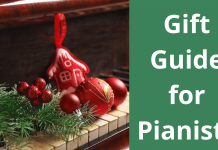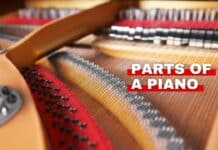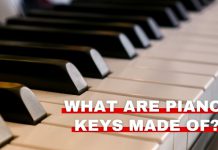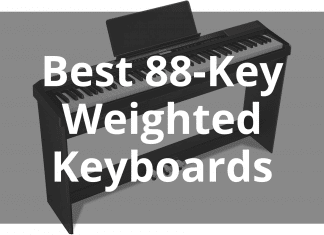The piano is a beautiful instrument. There are countless ways to go about learning it. Since everyone is different, it can be challenging to find the perfect learning method. However, if you do some digging, you’ll discover what’s best for you. Keep reading, and I’ll go through the best and easiest ways to learn this marvelous instrument.
Different Methods of Learning The Piano
If you’ve ever searched “how to learn piano,” you’ll know that endless people claim their method is best. You might even see transformation stories that inspire you. Since every method seemingly turns people into excellent pianists, how can anyone know what to trust? Here are the most popular ways to learn the piano:
- Piano lessons
- Online resources
- Teach yourself
Though each path can make you a superb pianist, the trajectories are different.
Piano Lessons
With piano lessons, it’s common to have them weekly for 30 to 60 minutes. Lessons can be great because teachers will help you become a well-rounded pianist. If you teach yourself, you might overlook important piano exercises or skills. However, not all teachers will create a specialized plan for you. This lack of a plan doesn’t feel personal, and it’s not ideal for learning. When choosing a teacher, it’s imperative to find one who will cater to your learning style. When all is said and done, you can acquire a well-rounded skill set within a few years. One major downside to piano lessons is the high cost. The average price of lessons is about $60 an hour. Let’s say you take 40 lessons in a year at $30 per session. The total cost would be $1,200. The truth is, lots of people can’t afford to spend this much. However, two factors would make it worth it: A strong desire to learn the piano and a personalized teacher. If you have the money and can find an excellent teacher, piano lessons might be worth it for you.
How to Learn Piano Online
Just by searching “how to learn piano online,” you’ll find endless amounts of resources. The great thing about online learning is the variety of material. If you’re a visual learner, you can level up your game with countless YouTube videos and apps. A great YouTube channel to check out is Mangoldproject. This user uploads piano lesson series’ for beginners and has been a relevant piano coach for years. You’ve probably seen the videos where notes fall onto the keys. These types of videos are also stellar for visual learners.
In terms of official online lessons, a great program is ArtistWorks. This program is a series of videos created by 3 famous pianists. You can choose which pianist from whom you want to learn. The options are Jazz, Classical, and Popular piano. Though these lessons are pre-recorded, they’re highly effective because you can pause or go back to a specific point.
Another pleasant option is an app called FlowKey. This app has step-by-step courses and over 1,500 song tutorials to increase your repertoire. A convenient option on this app is the ability to set your level from beginner, intermediate, advanced, or pro. The song learning feature shows you sheet music but with a twist. A marker indicator shows which chord or note you’re on in the sheet music and moves forward when you play it correctly.
If you want a program to help you reach a high level, you might try PianoForAll. Upon purchase, you immediately have access to 200 video courses, 9 eBooks, and 500 audio files. This program emphasizes different styles and rhythms. The eBooks cover topics like speed learning, classical piano, blues, chords, and more.
Teaching Yourself
Teaching yourself to play the piano can be a challenging endeavor, but if you do it right, you can become a superb pianist. So, what exactly is “right?” It turns out, right isn’t confined to one method. There are several correct ways to teach yourself the instrument. However, freedom comes with a cost. Without professional advice, there’s no guarantee you’ll learn some important basics. Here are some of them:
- Fingering
- Technique
- How to read sheet music
- Chords
- Practice methods
- Scales
Each of these things is highly important to become a good pianist. You might wonder: “Why is technique so important?” “If I can learn songs without using a good technique, do I really need it?” These are perfectly legitimate questions for a beginner pianist. The answer is simple: Proper technique prevents injury and getting arthritis in the future. A pianist who uses a bad technique for a long time can have permanent hand and wrist damage.
Learning the piano on your own is the most cost-efficient method out of them all. You can consult free online resources to elevate your skills. However, it’s best if you tread the internet carefully. As you probably know, it is full of scams and people wanting to take your money. If you invest in a learning program, make sure it’s trusted and reviewed by lots of people. The online programs and apps I mentioned are all widely-trusted.
If you teach yourself, you might overlook efficient practice methods. These aren’t the materials you practice, but rather the way you practice them. In truth, you don’t need to work very long each day to improve. With an efficient practice method, you might only need to practice for a half-hour. Here’s what a good practice method might look like:
Step 1: Warm-up
Before you get into the meat and potatoes of a practice session, it’s helpful to warm up. Contrary to popular belief, scales and exercises aren’t always the best warmups. They warm up your fingers, but not necessarily your mind. If you want to warm up both simultaneously, it’s highly beneficial to play a song you already know. Ideally, this song will be slow and free. A relaxed warmup song can work wonders to wake up your mind. If you start with exercises, you’ll be bored or burnt out within a few weeks. Save the exercises for the middle of the session.
Step 2: Main Objective For The Day
Once you’re warmed up, it’s time to make the real improvements. Your daily objective can be whatever you want it to be, small or large. For example, maybe you want to learn a new section of your favorite song. Your goal doesn’t necessarily need to be based on something you read online. Think about this question: Why do you want to learn the piano? Is it for the exercises, scales, etc.? Probably not. Maybe you see it as the pleasant instrument that it is, and you want to learn songs you enjoy. That’s the ticket. Use the middle of the practice session to reach your own goals. After about 30 minutes, take a break.
Step 3: Break
Practicing can be a laborious mental task, so it’s best to take a break in the middle. For 5 minutes, walk around, stretch, or do whatever you need to do to revitalize your mind. Think of this break as a pit stop. If you practice for a long time without a break, you’ll burn out.
Concluding The Session
Now is a good time to work on technical things like scales and exercises. Your mind is refreshed and ready for a challenge. The internet is riddled with free exercises you can use. A great resource to use is the Hanon book of exercises. This book costs money, but there are many free PDFs of it. Once you’re done with the technical practice, finish with a song you already know. It’s always pleasant to start a session with a bang and end with a bang as well. The goal is to make yourself want to practice again.
Which Method Is Best?
The answer to this question is different for everyone. Suppose you want a cost-effective, trustworthy path to learn the piano. In that case, you’ll likely enjoy programs like FlowKey, ArtistWorks, and PianoForAll. These programs are the best for people who want to know how to learn piano online. They’re also excellent if you’re a visual learner, as they show you the exact notes to play. ArtistWorks and PianoForAll are the best for aural and visual learners.
If you have the money and find a good teacher, your best choice might be piano lessons. Though they’re expensive, teachers will cover all the important aspects of playing. A great teacher can certainly offer personalized advice to take your piano game to the next level. With the COVID-19 pandemic, people have been looking toward online lessons more and more. You can find traditional-styled online lessons on many websites. A popular website is TakeLessons. However, there’s a significant downside to this option. Live virtual lessons in a traditional style are less practical than traditional in-person lessons. All it takes is one lousy internet connection to ruin the session.
If you’re looking to spend no money at all, your best bet is to teach yourself. Without help from a program or teacher, things will be more challenging. However, it’s still possible to become a revered pianist if you have the determination. Everything you’ll ever need to know about the piano is available for free online. The hard part is determining which resources to choose from. If you’ve ever stood at a vending machine, not knowing which snack to get, you’ll know that more options don’t equal an easier choice.
Conclusion
All in all, learning the piano is a highly rewarding process. Merely searching “how to learn piano” on the internet will give you mixed answers. The methods I’ve discussed are some of the most trusted and effective paths for beginners. It might take some time to get to a high level, but those skills will always stay with you. Listening to music is very enjoyable, but it’s even more satisfying to play it. Regardless of what you choose, the piano is waiting for you, so get to playing!
Table of Contents










